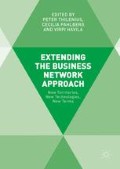Abstract
Over the years, research has covered many different aspects of business relationships; for example, there are streams investigating relationship initiation (e.g., Edvardsson et al. 2008), relationship development (e.g., Dwyer et al. 1987), critical episodes in relationships (e.g., Gidhagen 2002), relationship termination (e.g., Alajoutsijärvi et al. 2000), as well as network effects of relationships (e.g., Håkansson and Snehota 1995). However, there are few studies that focus on the time after a business relationship is terminated. A practical explanation may be the difficulty to study something ‘that is not,’ given, for instance, the reluctance to discuss any termination processes, or even problems of finding anyone with memories of the past. Another reason is of course that there may be considered little rationale in analysing something that is no more. However, this no-longer-existing business relationship may indeed be turned into ‘something’ again—once terminated, and later reactivated. In such a situation, the former relationship, its termination and also the time between termination and reactivation are all important aspects to consider.
Access this chapter
Tax calculation will be finalised at checkout
Purchases are for personal use only
Notes
- 1.
‘The Mining Company’ is an alias for the actual firm.
Bibliography
Ackerman, M. S. (1998). Augmenting organizational memory: A field study of answer garden. ACM Transactions on Information Systems, 16, 203–224.
Akgün, A., Keskin, H., & Byrne, J. (2012). Organizational emotional memory. Management Decision, 50, 95–114.
Alajoutsijärvi, K., Möller, K., & Tähtinen, J. (2000). Beautiful exit: How to leave your business partner. European Journal of Marketing, 34, 1270–1289.
Dwyer, F. R., Schurr, P. H., & Oh, S. (1987). Developing buyer-seller relationships. Journal of Marketing, 51, 11–27.
Edvardsson, B., Holmlund, M., & Strandvik, T. (2008). Initiation of business relationships in service-dominant settings. Industrial Marketing Management, 37, 339–350.
Ford, D. (1980). The development of buyer-seller relationships in industrial markets. European Journal of Marketing, 14, 339–353.
Gidhagen, M. (2002). Critical business episodes – The criticality of damage adjustment processes in insurance relationships. Doctoral thesis 91, Uppsala University, Department of Business Studies, Uppsala.
Giller, C., & Matear, S. (2001). The termination of inter-firm relationships. Journal of Business & Industrial Marketing, 16, 94–112.
Hadjikhani, A. (1996). Project marketing and the management of discontinuity. International Business Review, 5, 319–336.
Håkansson, H., & Snehota, I. (Eds.) (1995). Developing relationships in business networks. London: Routledge.
Halinen, A., & Tähtinen, J. (2002). A process theory of relationship ending. International Journal of Service Industry Management, 13, 163–180.
Harrison, D. (2004). Is a long-term business relationship an implied contract? Two views of relationship disengagement. Journal of Management Studies, 41, 107–125.
Havila, V., & Medlin, C. (2012). Ending-competence in business closure. Industrial Marketing Management, 41, 413–420.
Havila, V., & Wilkinson, I. (2002). The principle of conservation of business relationship energy: Or many kinds of new beginnings. Industrial Marketing Management, 31, 191–203.
Havila, V., Medlin, C., & Salmi, A. (2013). Project-ending competence in premature project closures. International Journal of Project Management, 31, 90–99.
Holmlund, M., & Hobbs, P. (2009). Seller-initiated relationship ending: An empirical study of professional business-to-business services. Managing Service Quality, 19, 266–285.
Levitt, B., & March, J. G. (1988). Organizational learning. Annual Review of Sociology, 14, 19–40.
Marshall, M. N. (1996). Sampling for qualitative research. Family Practice, 13, 522–525.
Poblete, L., Mizruchi, M. S., & Murnighan, J. K. (2015). Breakup and reconciliation: Reactivating business relationships. The 31th Annual IMP Conference, Kolding.
Pressey, A. D., & Mathews, B. P. (2003). Jumped, pushed or forgotten? Approaches to dissolution. Journal of Marketing Management, 19, 131–155.
Ritter, T., & Geersbro, J. (2011). Organizational relationship termination competence: A conceptualization and an empirical test. Industrial Marketing Management, 40, 988–993.
Skaates, M. A., Tikkanen, H., & Lindblom, J. (2002). Relationships and project marketing success. Journal of Business & Industrial Marketing, 17, 389–406.
Vaaland, T. I., Purchase, S., & Olaru, D. (2005). When techno-innovative relationships break up – What happens to the network? International Journal of Innovation & Technology Management, 2, 293–312.
Walsh, J. P., & Ungson, G. R. (1991). Organizational memory. Academy of Management Review, 16, 57–91.
Yin, R. K. (2009). Case study research: Design and methods (4th ed.,). Thousand Oaks: Sage.
Author information
Authors and Affiliations
Editor information
Editors and Affiliations
Copyright information
© 2016 The Editor(s) (if applicable) and The Author(s)
About this chapter
Cite this chapter
Gidhagen, M., Havila, V. (2016). From Business Remains to Reactivated Relationships. In: Thilenius, P., Pahlberg, C., Havila, V. (eds) Extending the Business Network Approach. Palgrave Macmillan, London. https://doi.org/10.1057/978-1-137-53765-2_15
Download citation
DOI: https://doi.org/10.1057/978-1-137-53765-2_15
Published:
Publisher Name: Palgrave Macmillan, London
Print ISBN: 978-1-137-53763-8
Online ISBN: 978-1-137-53765-2
eBook Packages: Business and ManagementBusiness and Management (R0)

